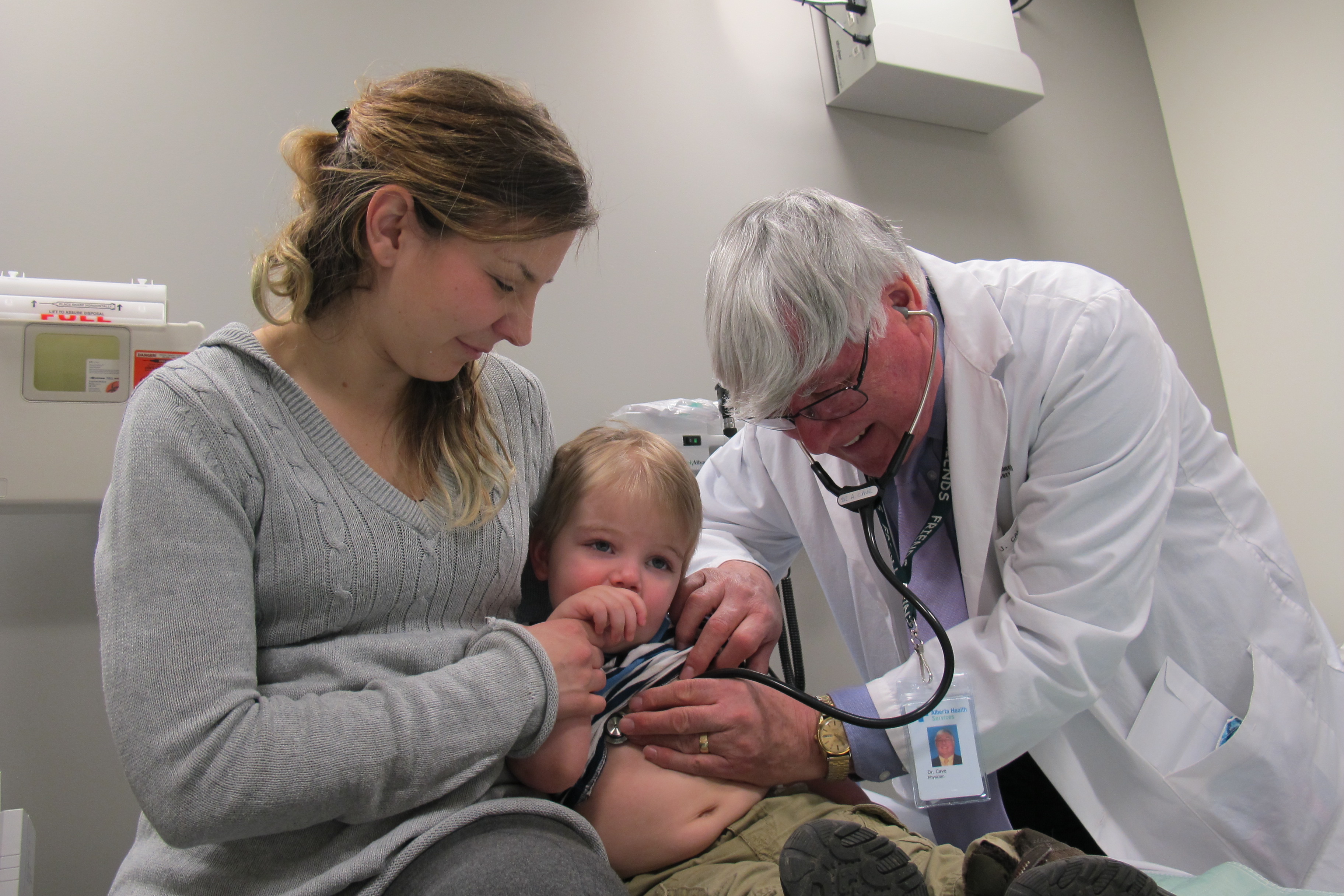
Andrew Cave listens in on the breathing of two-year-old Gabriel Carlson as his mother Katherine watches on at the Kaye Edmonton Clinic. Cave, a family physician and professor of family medicine at the Faculty of Medicine & Dentistry, is leading research that promises to help Alberta children with asthma breathe easier by putting a treatment guide directly into the electronic medical record with their family physician.
Nothing puts fear into a parent's heart like watching their child struggle to breathe.
"I've had a few scary moments with Gabriel," says his mother Katherine Carlson of St. Albert, who has asthma herself just like her two-year-old son. "We've been in the Emergency Department I don't know how many times. Every time he gets a cold, he can't breathe - so we end up going to Emergency to get it under control."
Echoing her fears is Erin White of Cochrane, whose seven-year-old son Noah has allergy-related asthma and requires a daily regime of inhalers and steroids.
White credits her careful management of Noah's steroid treatments for allowing the Grade 2 student to play forward in novice hockey. "He's a big goal-scorer, that kid, but last year he had to come off the ice once or twice per game just to take his inhaler, because he was getting so winded."
Children with asthma like Gabriel and Noah could soon be breathing easier, thanks to new research that will put a treatment guide directly into their electronic medical record with their family physician, to ensure they receive the best evidence-based care.
The Alberta Primary Care Pathway for Childhood Asthma - funded by a $750,000 grant from the Partnership for Research and Innovation between Alberta Health Services (AHS) and Alberta Innovates Health Solutions (AIHS) - will introduce this innovative mechanism to 22 medical practices across the province as a trial run to assess its benefits in managing childhood asthma in primary care settings. If the results are positive, a full provincial rollout is envisioned.
The three-year study from researchers at the University of Alberta and the University of Calgary is designed to help health professionals prescribe the right medication and encourage parents to fill and use their child's prescription properly. To this end, doctors will be given a "decision-making tree" in the child's electronic medical record to help make their diagnosis while their staff will receive more training to provide education on asthma treatments.
"Having a care guide in his medical record is an amazing idea," says White. "We've gone so many times to the urgent care centre when Noah couldn't catch his breath. We've had to go through his whole history every single time - which only delays his treatment. Having his information already there electronically would save me time and stress - and get him treated immediately."
Carlson concurs: "Having an electronic guide will be beneficial. Everyone will have access to the same information. We'll know exactly what Gabriel is being treated for."
"What we're attempting to improve is physician and parent management of asthma for their children," explains Andrew Cave, a family physician and professor of family medicine at the University of Alberta's Faculty of Medicine & Dentistry. "So we developed a template that can be inserted into a patient's electronic records for the doctor; they can click on it when a child with asthma comes through, and follow the path so the patient gets managed ideally."
"By ensuring that family practitioners have a convenient tool that helps them provide the optimal therapy, and by instructing the chronic-disease nurses in family practitioners' offices on how to best educate parents to manage their kids with asthma, we offer the best chance to prevent kids from having to visit Emergency or be hospitalized," says David Johnson, senior medical director of the AHS Maternal, Neonatal, Child and Youth Strategic Clinical Network, and professor of paediatrics, pharmacology and physiology at the University of Calgary, Cumming School of Medicine.
Cave and Johnson, who lead the project, are also both members the AHS Respiratory Health Strategic Clinical Network - the driving force behind the grant application - and a province-wide team which helps guide clinical research and care in Alberta.
"Changing the way health system solves complicated problems, comes from research. The work that Drs. Andrew Cave and David Johnson are doing underscores this," says Pamela Valentine, CEO interim of Alberta Innovates - Health Solutions. "Asthma can cause a lifetime of suffering. Using evidence to inform a solution to the problem, ultimately leads to improved health both for Albertans and people around the world."
Nurses, pharmacists and other clinicians will also be trained to talk with parents - many of whom fail to pick up or understand the importance of their child's prescription - and address their concerns over cost and assure them of the safety of steroid-based medications.
The work of Cave and Johnson builds on the earlier success of the Alberta Childhood Asthma Pathway (a way to deliver standard health care) that was rolled out over the past three years. Now in use at 105 AHS sites - including all emergency departments, urgent care centres and hospitals - it ensures kids get the best asthma care no matter where they live.
Asthma is the most common chronic disease in childhood, with at least 50 per cent of patients having poor control of the condition that results in frequent emergency treatment. As they promote greater and proper use of asthma medications, researchers also hope to reduce healthcare costs by decreasing the need for emergency department visits and hospital stays.
"That's a lot of kids who would be so much better," says Cave.
Alberta Primary Care Pathway for Childhood Asthma partners are: Alberta Health Services - Respiratory Health Strategic Clinical Network, Alberta Innovates Health Solutions, University of Alberta, University of Calgary, Health Quality Council of Alberta, Southern Alberta Primary Care Research Network, Northern Alberta Primary Care Research Network and Ottawa Hospital Research Institute.